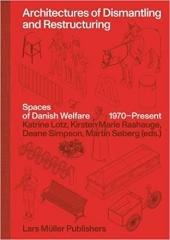This publication explores a series of urgent questions addressing architecture's role in the welfare and everyday life of citizens, from the interdisciplinary perspectives of architecture, art history and anthropology. With Denmark as a case, it examines how the spatiality of the welfare system has transformed, since the end of the so-called 'golden age of the welfare state' in the early 1970s until today. How have these spatial changes impacted upon the everyday lives and welfare experiences of citizens? What happens when long- standing institutions are restructured, dismantled or displaced elsewhere? How do emerging types of welfare space inform - or become informed by - changed understandings of the role of the welfare system in our everyday lives? Rather than unfolding a singular narrative of loss and nostalgia associated with welfare dismantlement - or one of triumphant humanization and restructuring of modernist planned environments - it describes shifting spatial materializations of welfare and the 'good life' at the intersection of these two tendencies, under the influence of a Danish version of the neoliberal turn and other important societal transformations.

(0 Comentarios)